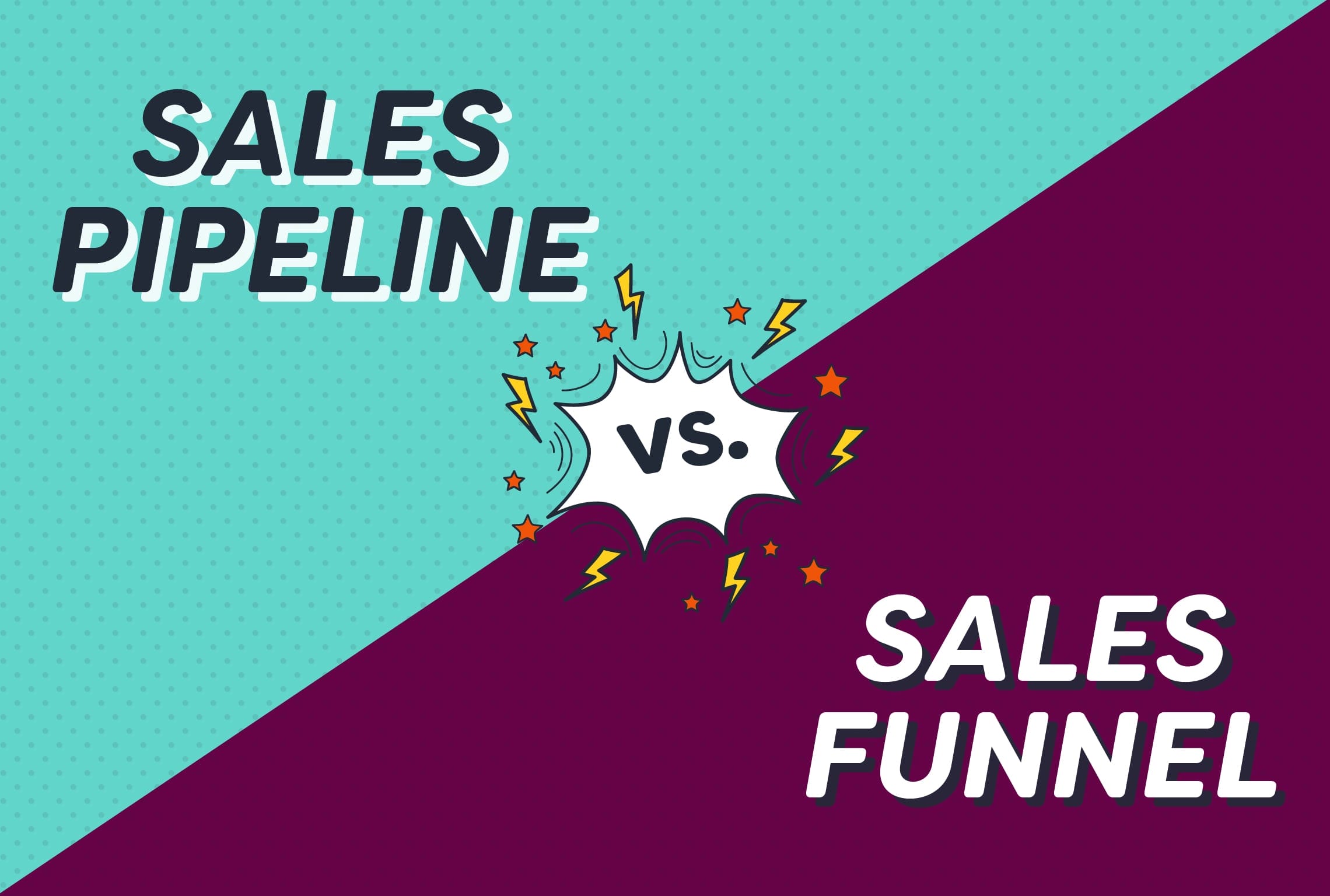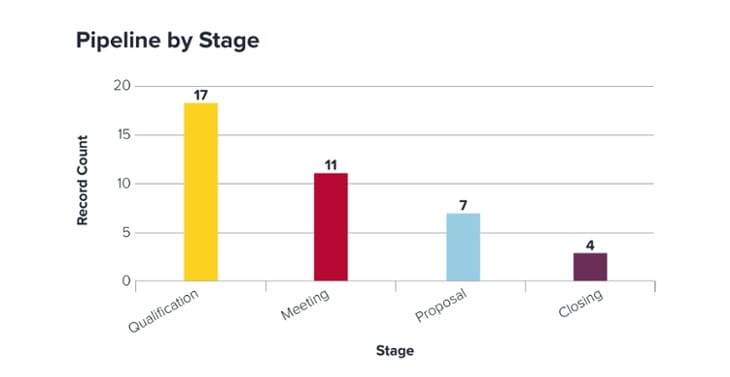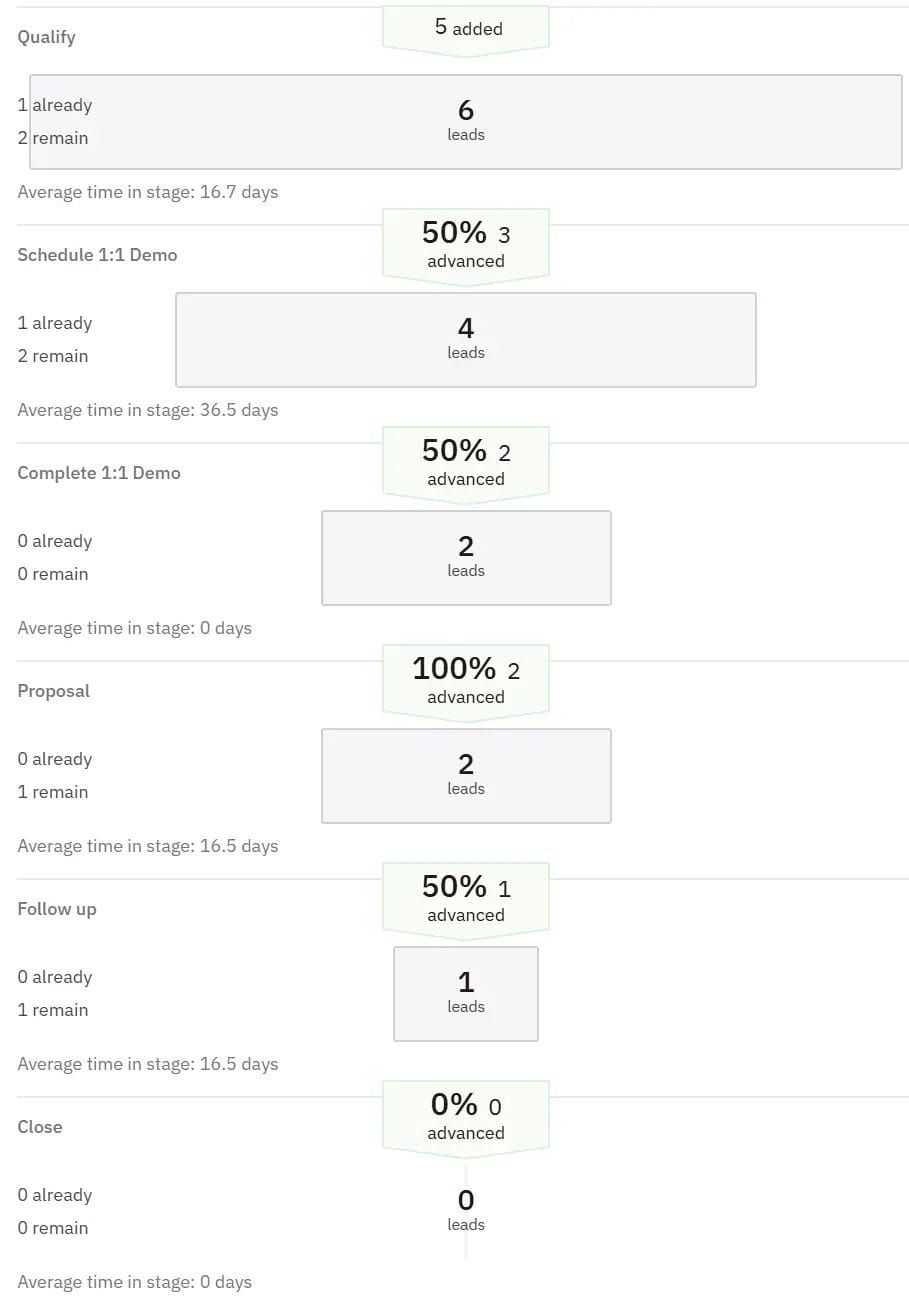Want to learn more about sales pipeline automation?
Learn how to set up your sales pipeline with custom automations to streamline your workflow and keep deals moving forward!

If you’ve been using “pipeline” and “funnel” to mean the same thing, you might want to pay attention.
Sales pipeline and sales funnel both describe the flow of prospects through a sale, but there’s an important difference between the two commonly confused terms. While the definition and meaning of a sales pipeline versus that of a sales funnel may seem similar, there are some fundamental differences.
A sales pipeline outlines the specific stages and actions a salesperson takes to move a prospect from a new lead to a customer. In contrast, a sales funnel represents the customer’s journey and measures the conversion rates of prospects as they move through these stages. While a pipeline focuses on the seller’s activities and what they can directly control, a funnel provides a broader view of the customer’s path to purchase and helps identify where leads are dropping off.
A sales pipeline is a set of stages that a prospect moves through as they progress from a new lead to a customer. Once each pipeline stage is completed, the prospect is advanced to the next stage.
Though the structure can differ from company to company when building a sales pipeline, here are some of the more common stages:
Now, here’s where things start to get confusing.
1) A sales pipeline is similar—but not identical—to a sales process, which refers to the recurring actions that a team takes on every lead to move them across those stages (i.e., distributing leads to the proper team member, calling new leads to qualify them, or doing research in advance of a presentation). The actions in a sales process are divided into pipeline stages.
2) Many sales professionals use “pipeline” or “sales pipeline” to mean the quantity or dollar value of the deals currently in their pipeline, not the series of sales stages themselves. It’s very common to hear a sales rep lament that their “pipeline is looking rough” because they let their prospecting efforts fall by the wayside or to hear a manager call a “pipeline meeting” to discuss the specific deals that the team has in progress.
What they’re really talking about is deal pipeline value, which is measured by a pipeline report.
While Nutshell uses the “series of stages” definition when referring to “sales pipelines” in our CRM, don’t be thrown off when you hear seasoned sales pros use it to mean “value of deals in progress.” As a wise band once sang, sometimes words have two meanings.
A pipeline report shows the value and quantity of all deals in each stage of the opportunity pipeline at the moment when the report is run.

Pipeline reports are important for effective pipeline management, helping sellers keep track of the status of every deal and understand whether they have an appropriate distribution of deals in order to meet their sales targets.
Related: The sales pipeline prescription: how to cure the 10 most common ailments plaguing your pipeline

Perhaps you’re wondering what a sales pipeline looks like. A sales pipeline is typically depicted as a horizontal bar broken up into the different sales process stages. For example, the sales pipeline pictured above shows a horizontal series of pipeline stages from Qualify to Close.
Transform your sales process with our comprehensive sales pipeline training guide. From filling your pipeline to pipeline management, learn it all.

Unlike a sales pipeline, which focuses on the set of actions taken by sellers, a sales funnel represents the quantity and conversion rates of prospects through your pipeline stages. It’s called a “funnel” because of its shape: wide at the top as prospects enter, then increasingly narrow as they are disqualified or decide not to buy.
Unlike a sales lead pipeline report, which shows the value and quantity of deals at the moment when the report is run, a funnel report is based on a cohort. This means that a funnel report can tell you, for example, of the 100 leads you received last quarter, what percentage of them advanced through each stage of your pipeline.

A sales cycle funnel report is important for sales leaders because it can help them forecast sales and identify where deals are getting stuck. A sales funnel forecast report is generated based on the current lead volume. And pinpointing bottlenecks in the funnel cycle helps them improve their process and better coach their team.

We know what a sales pipeline looks like—how does the look of a sales funnel differ? A sales funnel depicts the buyer journey in a vertical format, from when the lead enters the top of the funnel to the point at which the lead becomes a customer at the bottom.
Because the number of leads usually decreases from stage to stage, the sales funnel automatically takes on the shape of a funnel, as shown in the above picture of a sales funnel. For this reason, regardless of whether the funnel highlights the number of leads per stage or simply focuses on the types of stages in the sales process, the sales funnel is usually visualized in funnel form.
So, when you’re thinking about the difference between a pipeline and a funnel, remember this: A pipeline reflects what a seller does during the sales process and a funnel measures conversion rates through the sales process.
To sum up:
Get 70+ expert strategies for sales management success in our Sales Manager’s Survival Guide.

As you’ve probably realized, the sales pipeline and sales funnel are moving in the same direction along the buyer’s journey from discovery to close. That’s why you can – and should – use both to determine your business’s sales strategy.
The conversion rates found in the sales funnel report are a response to things that your sales team can control – sales rep actions, how they communicate, and how often they’re reaching out and working to move leads through the sales deal pipeline.
When analyzing conversion rates in your sales funnel, keeping your sales pipeline on hand can help you map seller actions directly to buyer conversions and find opportunities to improve your process.

Learn how to set up your sales pipeline with custom automations to streamline your workflow and keep deals moving forward!

Building an effective sales opportunity pipeline may seem complicated at first—there are several factors to consider to ensure you get it right. With a straightforward process in hand, building a sales lead pipeline geared toward moving prospects through the stages and encouraging more deals is simplified.
Let’s take a look at the core steps to create the best sales pipeline for your team and business success:
You’ve followed the steps outlined above and built a great sales pipeline to empower your sales team. What next? The next step is to implement a solid pipeline management process so you, your team, and your company get the most from your sales efforts.
We’ve already touched on continuous pipeline evaluation and optimization, but there’s more to pipeline management than just that. Here are some of the top tips for successfully managing a sales pipeline:
Want to turn your sales pipeline into a conversion machine? Take a tour of Nutshell and learn how our CRM’s sales process tools and insights help sales reps add more qualified leads to their pipeline and win more deals.
And with our Multiple Pipelines feature, Nutshell Pro users can even configure multiple sets of stages for distinctly different sales efforts, while draft pipelines (available to all users) make it easy to experiment with new processes before putting them into practice.
After exploring our robust suite of CRM features, why not try it out for yourself? Explore any Nutshell plan free for 14 days – no credit card required. Contact our team to learn more about how Nutshell can help your business create the ideal sales pipeline, whatever your sales model.
Both are essential, but they serve different forecasting purposes. Your pipeline helps forecast based on current deal stages and values, while your funnel uses historical conversion rates to predict future revenue. For the most accurate forecasts, use pipeline data for short-term projections and funnel metrics to identify long-term trends and bottlenecks.
Absolutely. Small businesses actually benefit more from using both tools together. Your pipeline keeps deals organized and moving forward, while your funnel reveals which stages need improvement. You don’t need complex systems—a simple CRM like Nutshell tracks both automatically, helping you close more deals without adding overhead or complexity to your process.
Watch for these red flags: deals stalling in one stage for weeks, conversion rates dropping between stages, inconsistent deal values, or reps spending too much time on low-quality leads. If your pipeline report shows uneven distribution or your funnel reveals high drop-off rates at specific stages, it’s time to optimize your process and retrain your team.
A marketing funnel focuses on building brand awareness and attracting potential customers through content, ads, and social media. Once someone shows buying intent, they enter your sales funnel, where your sales team guides them through evaluation, proposal, and closing stages. Marketing generates interest; sales converts that interest into revenue. Both work together in your customer journey.
Yes. Nutshell automatically tracks both your pipeline stages and funnel conversion rates in real time. You’ll get pipeline reports showing current deal status and values, plus funnel reports revealing conversion rates at each stage. Our reporting tools help you forecast revenue, identify bottlenecks, and coach your team—all without manual data entry or complex spreadsheets.
Have a question? Need to see more? Register for a free 30-minute Nutshell demo and product tour with one of our team members to determine if Nutshell is a match for your business.


Join 30,000+ other sales and marketing professionals. Subscribe to our Sell to Win newsletter!
